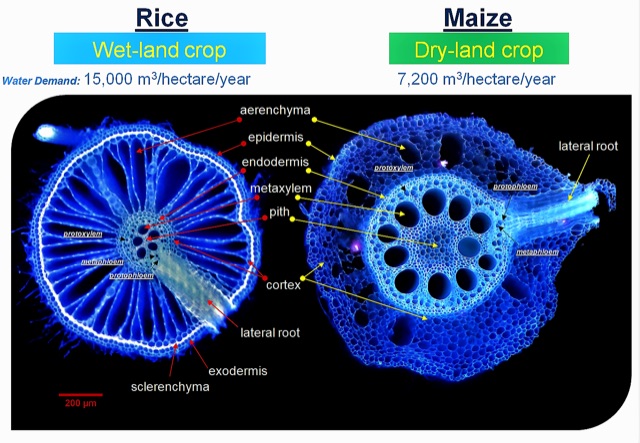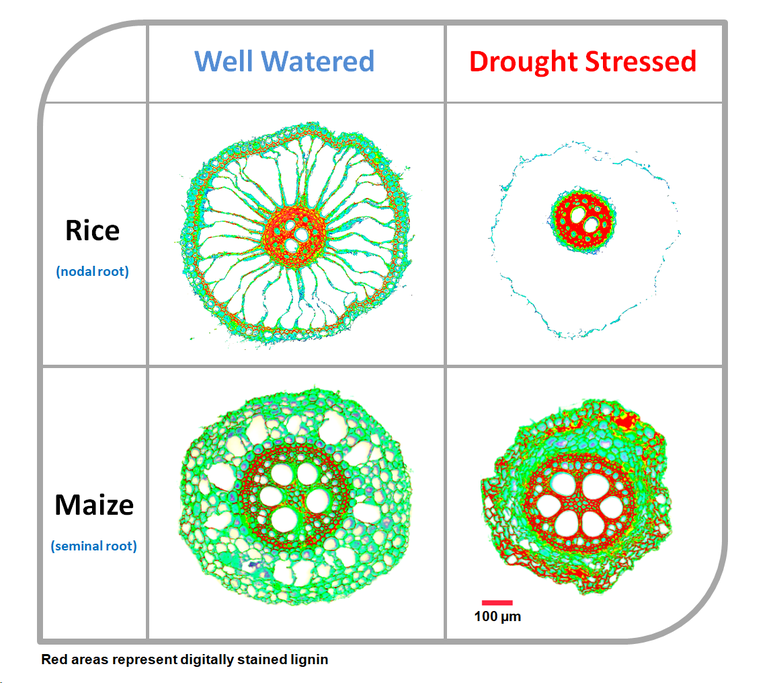Investigating the impact of root anatomical traits on drought tolerance, phosphorus deficiency, and nitrogen deficiency in the greenhouse and field.

Root anatomical phenes image
PIs: Jonathan Lynch, Kathleen Brown
Students:
Jenna Reeger, Penn State University
Stephanie Klein, Penn State University
Chris Strock, Penn State University
Project Summary
Investigating the role of genetic variation in root anatomy on soil resource acquisition is a major focus of our group. Variation in root anatomy can have a significant effect on the ability of a root system to forage for, take up, and transport soil resources under stress. Anatomical phenes that improve the balance between soil exploration and the consumption of growth limiting resources have been shown to be especially beneficial to crop productivity under both water and nutrient deficit. To study these concepts, we utilize agriculturally relevant species in effort to bear direct implications on the improvement of global cropping systems. We address our hypotheses through the utilization of in silico modeling, as well as greenhouse and field based trials.
Rice
Rice (Oryza sativa) is eaten by over half the world's population and is grown on over 164 MHA around the world. Especially in developing nations, many who eat and grow rice live in poverty. Low-input farming leads to nutrient deficiencies and drought stress during the growing season, and climate change is predicted to exacerbate drought in many areas. There is therefore a need for nutrient and drought stress resistant rice varieties.
Our previous work in maize and bean has shown that root anatomical and architectural phenes improve drought and nutrient deficiency tolerance. Although these trends have yet to be shown in rice, to date our work has demonstrated that significant variation in root anatomical phenes is present in rice and that many of these traits are influenced by P deficiency (Vejchasarn, Lynch & Brown. 2016).

Image courtesy of Mohamed Hazman

Image courtesy of Mohamed Hazman
Common Bean
The common bean (Phaseolus vulgaris L.) has long been one of the fundamental crops contributing to food security worldwide (Porch et al. 2013), with greater volume for direct human consumption than any other grain legume and more than half of global production located in regions where food deficit exists (Beebe 2014; Porch et al. 2013). Despite the significance of this crop in places like sub-Saharan Africa where 4 million hectares are cultivated by smallholder farmers, global yield of P. vulgaris is currently only 1/3 of what is achievable in developed nations where resources such as fertilizers, pesticides, and irrigation are available to reduce abiotic and biotic growth constraints (Beebe 2014; Porch et al. 2013). Productivity is further compounded by climate change, as global climate shifts will continue to reduce both the regions and seasons suitable for cultivation of this species by 2/3 (Ho et al. 2005; IPCC 2007; Porch et al. 2013).
We are currently working to determine the role of root anatomy on water transport efficiency under drought as well as phosphorus foraging efficiency under phosphorus deficit.

Image courtesy of Christopher Strock
References
Beebe, S. E., Rao, I. M., Devi, M. J., & Polania, J. (2014). Common beans, biodiversity, and multiple stresses: challenges of drought resistance in tropical soils. Crop & Pasture Science, 65(7), 667-675.
Ho, M. D., Rosas, J. C., Brown, K. M., & Lynch, J. P. (2005). Root architectural tradeoffs for water and phosphorus acquisition. Functional Plant Biology, 32(8), 737-748.
IPCC AR4 SYR (2007), Core Writing Team; Pachauri, R.K; and Reisinger, A., ed., Climate Change 2007: Synthesis Report, Contribution of Working Groups I, II and III to the Fourth Assessment Report of the Intergovernmental Panel on Climate Change, IPCC, ISBN 92-9169-122-4.
Porch, T. G., Beaver, J. S., & Brick, M. A. (2013). Registration of Tepary Germplasm with Multiple-Stress Tolerance, TARS-Tep 22 and TARS-Tep 32. Journal of Plant Registrations, 7(3), 358-364.
Vejchasarn P, JP Lynch, KM Brown. 2016. Genetic Variability in Phosphorus Responses of Rice Root Phenotypes, Rice, 9:29

